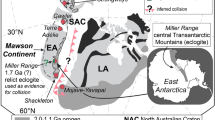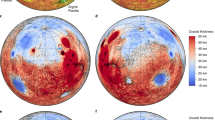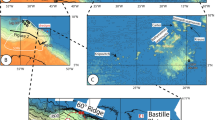Abstract
The stabilization of continental crust to form cratons represents one of the major features of Earth history1. Major structural, geochemical2,3 and, to a lesser extent, sedimentological changes4 associated with the development of stable crustal blocks are recorded mainly around 2,500 Myr ago1. This change, however, appears to have been globally diachronous and cratonic sequences as old as 3,100 Myr are recorded5. I now present the results of a recent regional stratigraphical and sedimentological study on the ∼2770 Myr old lower Fortescue Group6,7 (previously classified lithologically as Proterozoic8, but following the recent recommendation of a 2,500-Myr Archaean/Proterozoic chronological boundary9 is referred to as Archaean) in the Pilhara Block10, Western Australia. A major stabilization of the underlying granitoid–greenstone terrain appears to have pre-dated Fortescue basin formation. This event, which available geochronology suggests was relatively rapid, marked a major changing point in the tectonic evolution of the Pilhara Block.
This is a preview of subscription content, access via your institution
Access options
Subscribe to this journal
Receive 51 print issues and online access
$199.00 per year
only $3.90 per issue
Buy this article
- Purchase on Springer Link
- Instant access to full article PDF
Prices may be subject to local taxes which are calculated during checkout
Similar content being viewed by others
References
Cloud, P. Geol. Soc. S. Afr. Mem. Lect. Ser. 14, (1976).
McLennan, S. M. & Taylor, S. R. Geol. Soc. Aust. Abstr. 9, 172–173 (1983).
Veizer, J. & Compson, W. Geochim. cosmochim. Acta 40, 905–914 (1976).
Houston, R. S. & Karlstrom, K. E. Uranium-Bearing Quartz-Pebble Conglomerates (University of Wymoming Press, Laramie 1979).
Hunter, D. R. Precambrian of the Southern Hemisphere (Elsevier, Amsterdam, 1981).
Macleod, W. N. et al. West. Aust. Geol. Surv. a. Rep. 1962, 44–54 (1963).
Trendall, A. F. West. Aust. Geol. Surv. a. Rep. 1978, 63–71 (1979).
Dunn, P. R. et al. Aust. Bur. Miner. Res. Rec. 1966/72 172 (1966).
Sims, P. K. Precamb. Res. 13, 379–380 (1980).
Drummond, B. J. Bur. Miner. Res. J. Aust. Geol. Geophys. 8, 35–51 (1983).
Smith, R. E. et al. J. Petrol. 23, 75–102 (1982).
Jahn, B. M. et al. Geochim. cosmochim. Acta 45, 1633–1652 (1981)
de Laeter, J. R. & Blockley, J. G. J. geol. Soc. Aust. 19, 363–370 (1972).
de Laeter, J. R. et al. West Aust. Geol. Survey a. Rep. 1974, 73–79 (1975).
Hickman, A. H. Explanatory Notes for Nullagine 250,000 sheet (Geol. Surv. West. Aust., 1978).
Compston, W. et al. Geol. Soc. Aust. Abstr. 3, 40 (1981).
Hickman, A. H. Geol. Surv. West. Aust. Bull. 127, (1983).
Bur. Min. Res. Geol. Geophys. 1: 500,000, Bouguer Anom. Maps. F50/B2-11, F50/B2-12, F51/B2-5, F51/B2-9 (1972).
Horwitz, R. C. & Smith, R. E. Precamb. Res. 6, 293–322 (1978).
Tarling, D. H. J. geol. Soc. Lond. 137, 459–467 (1980).
Hunter, D. R. Precamb. Res. l, 295–326 (1974).
Parsons, B. & Schlater, J. G. J. geophys. Res. 82, 803 (1977).
Author information
Authors and Affiliations
Rights and permissions
About this article
Cite this article
Blake, T. Evidence for stabilization of the Pilbara Block, Australia. Nature 307, 721–723 (1984). https://doi.org/10.1038/307721a0
Received:
Accepted:
Issue Date:
DOI: https://doi.org/10.1038/307721a0
This article is cited by
-
The geological setting of the earliest life forms
Journal of Molecular Evolution (1985)
Comments
By submitting a comment you agree to abide by our Terms and Community Guidelines. If you find something abusive or that does not comply with our terms or guidelines please flag it as inappropriate.



